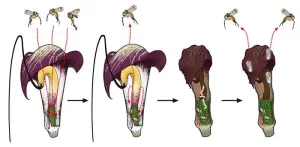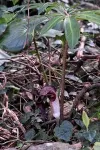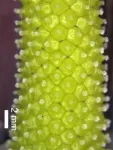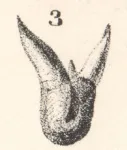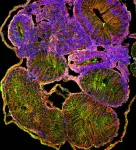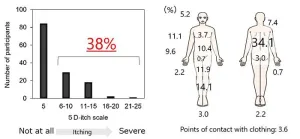(Press-News.org) In a group of plants that is famous for luring its pollinators into a death trap, one species offers its flowers as a nursery in exchange. The Kobe University discovery blurs the line between mutualism and parasitism and sheds light on the evolution of complex plant-insect interactions.
Many plants rely on animals for pollination and most offer rewards for the service. Some plants, however, deceive their pollinators, and a famous example is the genus Arisaema. “It is famous as the only plant that achieves pollination at the expense of the pollinator's life,” says Kobe University biologist SUETSUGU Kenji, who is an expert on plant pollination ecology. The plant uses a musky odor to lure fungus gnats that usually feed and lay their eggs on mushrooms into their cup-shaped flowers. The insects can escape from the male flowers, but only after tribulations that will result in them being covered in pollen. However, there is no escape from the female flowers. Once they enter these, the involuntary pollen carriers struggle to find an exit, which ensures that they will pollinate the flower, but they can't get a hold on the waxy interior and perish.
Suetsugu's group has a “long-standing interest in the genus Arisaema, but we are also dedicated to challenging traditional views in pollination biology. This drove us to look beyond the apparent antagonistic relationship and designing experiments that could uncover a more nuanced interaction.” They collected male and female flowers of a particular Arisaema species, A. thunbergii, and looked closely both at what species of insects got trapped and at what happens to the flowers after pollination.
The surprising results are now published in the journal Plants, People, Planet. The Kobe University team found that the main pollinator, a fungus gnat by the name of Leia ishitanii, lays its eggs into the flowers and that the larvae feed on the decaying flowers, developing into adult fungus gnats that emerge after a few weeks. Furthermore, they also sometimes found gnats emerge from flowers without any corpses of members of that species. This suggests that at least some of the insects are actually able to escape the trap. Suetsugu explains, “This finding adds a new dimension to our knowledge of plant-insect interactions, but the most exciting aspect is that even in well-studied fields, there is still much to learn. Nature is full of surprises!”
Suetsugu explains further, “The interaction between the plant and the insect probably still differs from other typical examples of nursery mutualism.” The fungus gnats do not exclusively depend on A. thunbergii as a nursery and so the ones that get permanently trapped in the flower are deprived of further egg-laying opportunities elsewhere. Thus, the interaction probably still comes at a cost for the insects, but there is also an aspect of mutualism the like of which has not been found in other members of the Arisaema genus. “We suggest that the interaction likely represents an intermediate stage in the evolution of nursery pollination mutualism,” says the Kobe University biologist.
Thus, A. thunbergii might be an example of an unusual evolutionary process from deception to mutualism. However, the research team speculates that by looking more closely at other members of the Arisaema genus, similar kinds of interactions might still be found. Suetsugu says that his team’s result therefore “highlights the need to refine existing models of pollination biology beyond the traditional mutualistic or deceptive paradigms, thus contributing to a more nuanced understanding of plant-pollinator dynamics.”
This study was financially supported by the Japan Science and Technology Agency PRESTO program (JPMJPR21D6) and the Japan Society for the Promotion of Science Grants-in-Aid for Scientific Research (19H03292). It was conducted in collaboration with researchers from Showa University, the National Museum of Nature and Science Tsukuba, and the Forest Research and Management Organization.
Kobe University is a national university with roots dating back to the Kobe Commercial School founded in 1902. It is now one of Japan's leading comprehensive research universities with nearly 16,000 students and nearly 1,700 faculty in 10 faculties and schools and 15 graduate schools. Combining the social and natural sciences to cultivate leaders with an interdisciplinary perspective, Kobe University creates knowledge and fosters innovation to address society’s challenges.
END
Pollinator's death trap turns into nursery
2024-02-19
ELSE PRESS RELEASES FROM THIS DATE:
Studies find flu vaccines were effective in 2022-2023 flu season
2024-02-19
The prospect of the worrisome triple threat of COVID, RSV and flu was assuaged last year by the effectiveness of flu vaccines. Two recent studies from the Centers for Disease Control and Prevention’s VISION Network have found that flu vaccines were effective for all ages against both moderate and severe flu in the U.S. during the 2022-2023 flu season.
Both the pediatric and adult VISION Network studies analyzed flu-associated emergency department (E.D.)/urgent care visits (indicative of moderate disease) and hospitalization (indicative of severe disease) from October 2022 through March 2023, a flu season in which far fewer individuals were social distancing or ...
Second year of Cal Poly astronomy fellowship to examine high-energy particle jets near supermassive black holes
2024-02-19
February 16, 2024
Contact: Nick Wilson
805-235-8008; nwilso28@calpoly.edu
Second Year of Cal Poly Astronomy Fellowship to Examine High-Energy Particle Jets Near Supermassive Black Holes
SAN LUIS OBISPO — In the second year of the Astronomy Faculty Research Fellowship in Cal Poly’s Bailey College of Science and Mathematics, a research team will study extremely high-energy photons emitted by the extreme environment found near mega-sized black holes.
The fellowship was ...
To boost a preschooler’s language skills, consider reminiscing
2024-02-19
Language skills are strong predictors of academic, socioemotional and behavioral outcomes when children enter school. They learn language in preschool years by interacting with others, especially their parents. Book sharing is a popular way parents engage young children in conversation. However, not all parents are comfortable with book sharing and not all children like having books read to them.
A new study on “parent talk” by Florida Atlantic University, in collaboration with Aarhus University in Denmark, provides ...
Husker team wins prize in contest to treat disease through gene editing
2024-02-19
Lincoln, Nebraska, Feb. 19, 2024 — A Husker research duo was named a first-round winner in a National Institutes of Health competition aimed at generating solutions for delivering genome-editing technology to the cells of people with rare and common diseases.
Janos Zempleni, Willa Cather Professor of molecular nutrition, and Jiantao Guo, professor of chemistry, were selected as Phase 1 winners in the NIH’s Targeted Genome Editor Delivery Challenge. The challenge is a three-phase competition with prizes totaling $6 million; the University of Nebraska–Lincoln team was among 30 initial recipients announced in December ...
Why two prehistoric sharks found in Ohio got new names
2024-02-19
COLUMBUS, Ohio – Until recently, Orthacanthus gracilis could have been considered the “John Smith” of prehistoric shark names, given how common it was.
Three different species of sharks from the late Paleozoic Era – about 310 million years ago – were mistakenly given that same name, causing lots of grief to paleontologists who studied and wrote about the sharks through the years and had trouble keeping them apart.
But now Loren Babcock, a professor of earth sciences at The Ohio State University, has finished the arduous task of renaming two of the three sharks – and in the process rediscovered a wealth ...
Study reveals five common ways in which the health of homeless pet owners and their companions is improved
2024-02-19
A rapid scoping review has been conducted which reveals five common ways in which the health of homeless pet owners and their companion animals is improved.
Ten percent of homeless people keep pets. But little information exists on specific intervention strategies for improving the health of homeless people and their pets who are often the only source of unconditional love or companionship in their life.
The study, published in the Human-Animal Interactions journal, found that the most common ways ...
Potassium depletion in soil threatens global crop yields
2024-02-19
Potassium deficiency in agricultural soils is a largely unrecognised but potentially significant threat to global food security if left unaddressed, finds new research involving researchers at UCL, University of Edinburgh and the UK Centre for Ecology & Hydrology.
The study, published in Nature Food, found that more potassium is being removed from agricultural soils than is being added, throughout many regions of the world. It also gives a series of recommendations for how to mitigate the issue.
Potassium is a vital nutrient for plant growth that ...
Poorly coiled frog guts help scientists unravel prevalent human birth anomaly
2024-02-19
How does our intestine, which can be at least 15 feet long, fit properly inside our bodies? As our digestive system grows, the gut tube goes through a series of dramatic looping and rotation to package the lengthening intestine. Failure of the gut to rotate properly during development results in a prevalent, but poorly understood, birth anomaly called intestinal malrotation. Now, in a study published in the journal Development, scientists from North Carolina State University have uncovered a potential cause of this life-threatening condition.
Intestinal malrotation affects 1 in 500 births but the underlying causes are not well understood. ...
Unveiling uremic toxins linked to itching in hemodialysis patients
2024-02-19
Niigata, Japan – Dr. Yamamoto et al. found the several uremic toxins as one of causes of itching in hemodialysis patients. Hemodialysis patients commonly experience itching on a daily basis, which is distributed throughout their bodies. They developed a "PBUT score" based on highly protein-bound uremic toxins (PBUT) that increase in the body with end-stage kidney disease. The PBUT score was associated with itching in hemodialysis patients.
I. Background of the Study
Patients with advanced chronic kidney disease (CKD) require kidney replacement therapy, such as hemodialysis, to manage their condition. Hemodialysis patients often experience various symptoms, ...
Communities must get prepared for increased flooding due to climate change, expert warns
2024-02-19
Communities must be better prepared for flooding in their homes and businesses, an expert warns, as climate change predictions suggest more extreme flooding globally.
Floods still inflict major costs to the economies, livelihoods and wellbeing of communities, with flood risks and impacts set to increase further due to climate change (IPCC, 2021).
Professor of Environmental Management, Lindsey McEwen explains how many experts now believe local communities have critical roles as key actors within flood risk management and disaster risk reduction.
Professor McEwen, author of Flood ...
